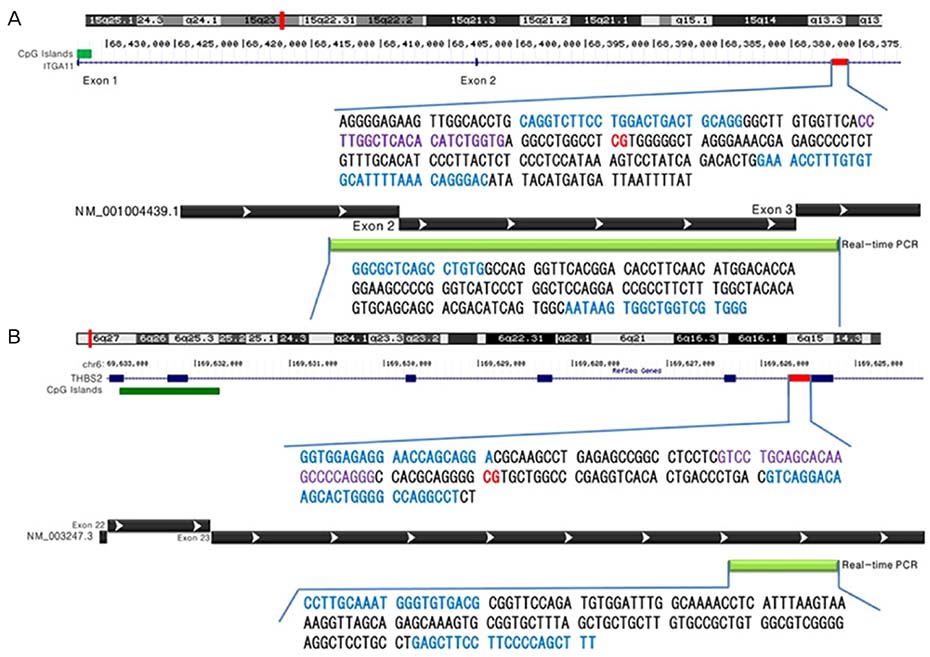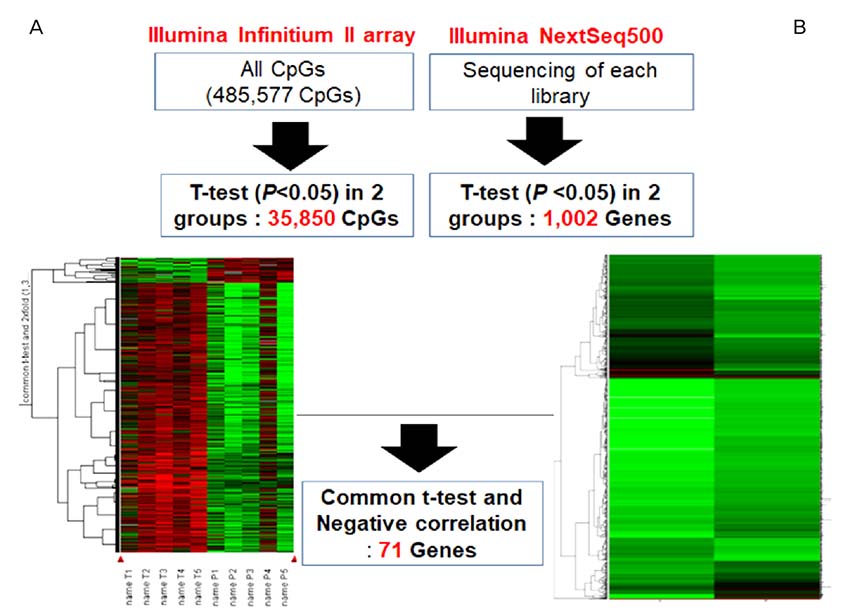Obstet Gynecol Sci.
2018 Sep;61(5):565-574. 10.5468/ogs.2018.61.5.565.
Differential expression and methylation of integrin subunit alpha 11 and thrombospondin in the amnion of preterm birth
- Affiliations
-
- 1Department of Obstetrics and Gynecology, Ewha Womans University College of Medicine, Seoul, Korea. kkyj@ewha.ac.kr
- 2Ewha Medical Institute, Ewha Medical Center, Ewha Womans University College of Medicine, Seoul, Korea.
- KMID: 2426021
- DOI: http://doi.org/10.5468/ogs.2018.61.5.565
Abstract
OBJECTIVE
This study aimed to investigate the association between preterm birth and epigenetic mechanisms in the amnion.
METHODS
We examined the association between differentially methylated regions (DMRs) and differentially expressed genes (DEG) using a cytosine-phosphate-guanine methylation array and whole-transcriptome sequencing from the amnion (preterm birth, n=5; full term, n=5). We enrolled 35 participants for mRNA expression analysis and pyrosequencing: 16 full-term and 19 preterm subjects. We compared the association of integrin subunit alpha 11 (ITGA11) and thrombospondin 2 (THBS2) gene methylation status with mRNA expression in the amnion.
RESULTS
In the preterm birth group, methylation of ITGA11 and THBS2 genes was significantly lower (ITGA11 gene: 60.30% vs. 73.16%, P < 0.05; THBS2 gene: 64.59% vs. 73.16%, P < 0.05), and the expression of the genes was significantly higher than that in the full-term group (ITGA11 gene: 14.20 vs. 1.57, P < 0.01; THBS2 gene: 1.18 vs. 10.34, P < 0.05).
CONCLUSION
Methylation of the ITGA11 and THBS2 genes in the amnion was associated with preterm birth. Thus, ITGA11 and THBS2 gene methylation status in the amnion may be valuable in explaining the mechanism underlying preterm birth.
MeSH Terms
Figure
Cited by 1 articles
-
Cervicovaginal fluid cytokines as predictive markers of preterm birth in symptomatic women
Sunwha Park, Young-Ah You, Hayoung Yun, Suk-Joo Choi, Han-Sung Hwang, Sae-Kyung Choi, Seung Mi Lee, Young Ju Kim
Obstet Gynecol Sci. 2020;63(4):455-463. doi: 10.5468/ogs.19131.
Reference
-
1. Arzuaga BH, Lee BH. Limits of human viability in the United States: a medicolegal review. Pediatrics. 2011; 128:1047–1052.
Article2. Parets SE, Bedient CE, Menon R, Smith AK. Preterm birth and its long-term effects: methylation to mechanisms. Biology (Basel). 2014; 3:498–513.3. Lim JW. The changing trends in live birth statistics in Korea, 1970 to 2010. Korean J Pediatr. 2011; 54:429–435.
Article4. Bhutta AT, Cleves MA, Casey PH, Cradock MM, Anand KJ. Cognitive and behavioral outcomes of school-aged children who were born preterm: a meta-analysis. JAMA. 2002; 288:728–737.5. Hwang HS, Na SH, Hur SE, Lee SA, Lee KA, Cho GJ, et al. Practice patterns in the management of threatened preterm labor in Korea: a multicenter retrospective study. Obstet Gynecol Sci. 2015; 58:203–209.
Article6. Parry S, Strauss JF 3rd. Premature rupture of the fetal membranes. N Engl J Med. 1998; 338:663–670.
Article7. Niknejad H, Peirovi H, Jorjani M, Ahmadiani A, Ghanavi J, Seifalian AM. Properties of the amniotic membrane for potential use in tissue engineering. Eur Cell Mater. 2008; 15:88–99.
Article8. Mamede AC, Carvalho MJ, Abrantes AM, Laranjo M, Maia CJ, Botelho MF. Amniotic membrane: from structure and functions to clinical applications. Cell Tissue Res. 2012; 349:447–458.
Article9. Kim J, Pitlick MM, Christine PJ, Schaefer AR, Saleme C, Comas B, et al. Genome-wide analysis of DNA methylation in human amnion. Sci World J. 2013; 2013:678156.
Article10. Arikat S, Novince RW, Mercer BM, Kumar D, Fox JM, Mansour JM, et al. Separation of amnion from choriodecidua is an integral event to the rupture of normal term fetal membranes and constitutes a significant component of the work required. Am J Obstet Gynecol. 2006; 194:211–217.
Article11. Lei H, Furth EE, Kalluri R, Chiou T, Tilly KI, Tilly JL, et al. A program of cell death and extracellular matrix degradation is activated in the amnion before the onset of labor. J Clin Invest. 1996; 98:1971–1978.
Article12. Sundrani DP, Chavan-Gautam PM, Pisal HR, Mehendale SS, Joshi SR. Matrix metalloproteinase-1 and -9 in human placenta during spontaneous vaginal delivery and caesarean sectioning in preterm pregnancy. PLoS One. 2012; 7:e29855.
Article13. Chen TH, Shih CY, Hsu WL, Chou TC. Mechanisms of nifedipine-downregulated CD40L/sCD40L signaling in collagen stimulated human platelets. PLoS One. 2015; 10:e0127054.
Article14. Ulahannan N, Greally JM. Genome-wide assays that identify and quantify modified cytosines in human disease studies. Epigenetics Chromatin. 2015; 8:5.
Article15. Flenady V, Wojcieszek AM, Papatsonis DN, Stock OM, Murray L, Jardine LA, et al. Calcium channel blockers for inhibiting preterm labour and birth. Cochrane Database Syst Rev. 2014; 6:CD002255.
Article16. Chan LW, Sahota DS, Yeung SY, Leung TY, Fung TY, Lau TK, et al. Side-effect and vital sign profile of nifedipine as a tocolytic for preterm labour. Hong Kong Med J. 2008; 14:267–272.17. Kajimoto H, Hashimoto K, Bonnet SN, Haromy A, Harry G, Moudgil R, et al. Oxygen activates the Rho/Rho-kinase pathway and induces RhoB and ROCK-1 expression in human and rabbit ductus arteriosus by increasing mitochondria-derived reactive oxygen species: a newly recognized mechanism for sustaining ductal constriction. Circulation. 2007; 115:1777–1788.18. Shi L, Wu J. Epigenetic regulation in mammalian preimplantation embryo development. Reprod Biol Endocrinol. 2009; 7:59.
Article19. Mitsuya K, Singh N, Sooranna SR, Johnson MR, Myatt L. Epigenetics of human myometrium: DNA methylation of genes encoding contraction-associated proteins in term and preterm labor. Biol Reprod. 2014; 90:98.
Article20. Parets SE, Conneely KN, Kilaru V, Fortunato SJ, Syed TA, Saade G, et al. Fetal DNA methylation associates with early spontaneous preterm birth and gestational age. PLoS One. 2013; 8:e67489.
Article21. Knight AK, Smith AK. Epigenetic biomarkers of preterm birth and its risk factors. Genes (Basel). 2016; 7:E15.
Article22. Huang W, Sherman BT, Lempicki RA. Systematic and integrative analysis of large gene lists using DAVID bioinformatics resources. Nat Protoc. 2009; 4:44–57.
Article23. Nunes V, Cross J, Speich JE, Morgan DR, Strauss JF 3rd, Ramus RM. Fetal membrane imaging and the prediction of preterm birth: a systematic review, current issues, and future directions. BMC Pregnancy Childbirth. 2016; 16:387.
Article24. Moore RM, Mansour JM, Redline RW, Mercer BM, Moore JJ. The physiology of fetal membrane rupture: insight gained from the determination of physical properties. Placenta. 2006; 27:1037–1051.
Article25. Woods JR Jr. Reactive oxygen species and preterm premature rupture of membranes-a review. Placenta. 2001; 22:Suppl A. S38–S44.
Article26. Strohl A, Kumar D, Novince R, Shaniuk P, Smith J, Bryant K, et al. Decreased adherence and spontaneous separation of fetal membrane layers--amnion and choriodecidua--a possible part of the normal weakening process. Placenta. 2010; 31:18–24.27. Popov C, Radic T, Haasters F, Prall WC, Aszodi A, Gullberg D, et al. Integrins α2β1 and α11β1 regulate the survival of mesenchymal stem cells on collagen I. Cell Death Dis. 2011; 2:e186.
Article28. Bornstein P, Agah A, Kyriakides TR. The role of thrombospondins 1 and 2 in the regulation of cell-matrix interactions, collagen fibril formation, and the response to injury. Int J Biochem Cell Biol. 2004; 36:1115–1125.
Article29. Lehnert K, Ni J, Leung E, Gough SM, Weaver A, Yao WP, et al. Cloning, sequence analysis, and chromosomal localization of the novel human integrin alpha11 subunit (ITGA11). Genomics. 1999; 60:179–187.30. Ji H, Long V, Briody V, Chien EK. Progesterone modulates integrin alpha2 (ITGA2) and alpha11 (ITGA11) in the pregnant cervix. Reprod Sci. 2011; 18:156–163.31. Peavey M, Salleh N, Leppert P. Collagen-binding α11 integrin expression in human myometrium and fibroids utilizing a novel RNA in situ probe. Reprod Sci. 2014; 21:1139–1144.32. Hynes RO. Integrins: bidirectional, allosteric signaling machines. Cell. 2002; 110:673–687.33. Stenczer B, Molvarec A, Veresh Z, Gullai N, Nagy GR, Walentin S, et al. Circulating levels of the anti-angiogenic thrombospondin 2 are elevated in pre-eclampsia. Acta Obstet Gynecol Scand. 2011; 90:1291–1295.
Article34. Tiger CF, Fougerousse F, Grundström G, Velling T, Gullberg D. Alpha11beta1 integrin is a receptor for interstitial collagens involved in cell migration and collagen reorganization on mesenchymal nonmuscle cells. Dev Biol. 2001; 237:116–129.35. Akins ML, Luby-Phelps K, Bank RA, Mahendroo M. Cervical softening during pregnancy: regulated changes in collagen cross-linking and composition of matricellular proteins in the mouse. Biol Reprod. 2011; 84:1053–1062.36. Chang IW, Li CF, Lin VC, He HL, Liang PI, Wu WJ, et al. Prognostic impact of thrombospodin-2 (THBS2) overexpression on patients with urothelial carcinomas of upper urinary tracts and bladders. J Cancer. 2016; 7:1541–1549.
Article
- Full Text Links
- Actions
-
Cited
- CITED
-
- Close
- Share
- Similar articles
-
- Expression of Tissue Tissue-transglutaminase-2 (TGM2) and Cyclo-oxygenase (COX) in the Fetal Membrane of Preterm Birth
- Expression of Adhesion Molecules in Placenta and Correlation with Uterine Artery Doppler Velocimetry in Pregnancy-induced Hypertension
- Hair Follicular Expression of Integrin Alpha-6 Subunit and p63 in Hair Loss
- Expression Profiles of Immune-related Genes in Fluoxetine-treated Human Mononuclear Cells by cDNA Microarray
- The Differential Gene Expression in Corneal Fibroblast Cultured with Amniotic Membrane Components




